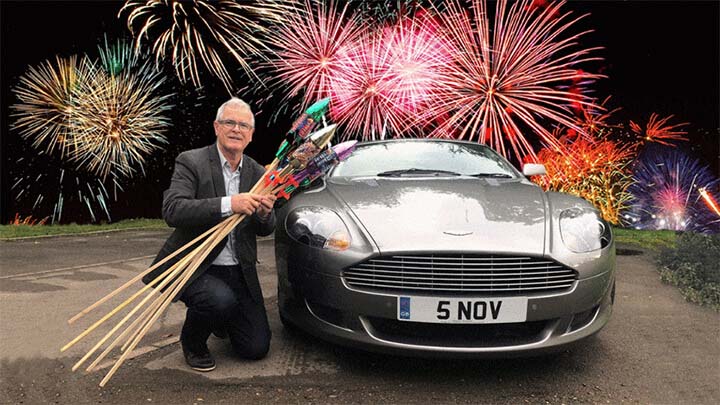
Pretty much everyone in the UK knows what Guy Fawkes Night (AKA Fireworks Night, AKA Bonfire Night) is about.
Even if we don't know the detailed history, most of us are aware that the bizarre celebration alludes to the 1605 Gunpowder Plot, when a group of disgruntled Catholics tried to blow up the Houses of Parliament and King James I. James wasn't a fan of Catholicism and he'd been making life pretty difficult for adherents, hence the attempt to remove him with a bang.
Why did we call it a bizarre celebration? Well, however one looks at it, the traditional burning of a human effigy isn't really in the spirit of a religious thanksgiving service, which is what the Observance of 5th November Act 1605 actually sought to establish. In fact, until its repeal in 1859, the act made it technically illegal not to attend church to give thanks for the survival of Lucky Jim I and his entourage.
You WILL be thankful, by order of the king
The Thanksgiving Act, as it came to be known, made no reference to fireworks or to bonfires. It certainly didn't require burning effigies of Guy Fawkes or the pope (the latter being the figure commonly assigned to the flames in early versions of the bonfire tradition). Overall, what began as a celebration of the king's survival through divine intervention, came to look like either a celebration of the uncomfortable deaths of Fawkes and his co-conspirators (the bonfire and effigies thing), or of the plot itself (the gunpowder and mini-explosions thing).
Regardless of whether one views Fawkes as a murderous terrorist or as the last man to enter parliament with honest intentions, it's pretty clear that Bonfire Night's focus strayed rather from the religious service the legislators had in mind.
So, while we all have a vague idea of the reasons for our annual habit of setting things alight, there's more to it than we might appreciate. Here are a few things you may not know about gunpowder, the plot, fireworks and the whole kerfuffle.
Fireworks
-
More than 400 years after the Gunpowder Plot, the fireworks we use to commemorate it are still made largely from good, old-fashioned gunpowder. The powder used today has a similar sulfur (or "sulphur" as we used to spell it in the UK), potassium nitrate and carbon composition to the original black powder invented in 9th century China.
-
While gunpowder produces the basic whizzes and bangs on November 5th, the pretty colours and effects are achieved by cleverly adding additional mineral ingredients. Barium gives a bright green, copper makes blue, sodium makes yellow and strontium makes deep red. Mixtures of elements yield more colours: strontium and sodium gives bright orange; titanium, zirconium and magnesium produce silvery white; copper and strontium make lavender and iron filings and small charcoal chips make golden sparks. Extra bright flashes and extra loud bangs are helped along by aluminium powder.
-
The active mixtures in fireworks are held together by a starchy paste known as a binder. As well as keeping things stable, the binder can be used to influence the speed and timing of detonations.
-
Many retailers, including supermarket giant Asda, now sell quiet fireworks in a bid to make the event less worrying for animals and people who are nervous of traditional fireworks.
-
Regtransfers has a selection of tips to help you enjoy November 5th safely.
Bonfire Night number plates?
Jon Culverhouse, founder of top pyrotechnics company Fantastic Fireworks, bought the perfect private registration number to celebrate and promote his business. He acquired his eye-catching 5 NOV plates in 1999 and, to this day, still features them on the Fantastic Fireworks website! Jon says:

I went out and bought the number plate 5 NOV. To judge by the many admiring glances and phone calls it has generated it was probably the best £10,000 I ever spent!
See our selection of Bonfire Night themed number plates!
The infamous plot
-
Although Guy or Guido Fawkes has, for centuries, been the name most associated with the Gunpowder Plot, the organiser of the debacle was actually an English Catholic named Robert Catesby.
-
Fawkes's fame is probably due to the fact that he was the man apprehended at the scene. He was discovered in a cellar along with a pile of firewood. He was carrying matches. The actual gunpowder (36 barrels of it!) was found a bit later on.
-
When he was caught, Fawkes claimed his name was John Johnson.
-
The plot failed due to an anonymous tip-off. Catholic peer Lord Monteagle was given a letter by a servant who had received it from a stranger. The letter warned Lord Monteagle not to attend the opening of Parliament. Moneagle passed the letter to James I’s chief minister Robert Cecil, and the Houses of Parliament were subsequently searched and Fawkes caught.
-
Organiser Catesby and several plotters were killed trying to escape the authorities. The rest of the perpetrators were tried and convicted of treason. They were executed in particularly unpleasant fashion. For those who really want to know, the gruesome details are available from all good online encyclopaedias.
Have a safe and enjoyable Guy Fawkes Night!
